
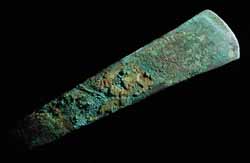 |
Copper axe with preserved woven-fiber material, Sister Creeks site, Fulton County. | |
|
It is not clear why Woodland-period people wrapped this copper axe in a piece of woven fiber. The type of plant fiber and the style of weaving can often be determined by examining the material with a microscope. |
||
The oldest examples of Native American clothing in Illinois come from Woodland period sites. At the Ogden-Fettie site in Fulton County, Middle Woodland copper objects have been found with bits of fabric still adhering to their surfaces. The fabric was preserved by copper sulfate, a compound produced when copper comes in contact with moist air. The type of plant fiber used to make the fabric, and the way the fabric was woven, are often visible when magnified. Many different plant fibers, including basswood, were used to weave cloth.
At a Middle Woodland period site in Pike County, archaeologists found cone-shaped pieces of copper that appear to have been attached to the clothing of a man. The cones may have jingled when the man walked or danced.
Part of a Late Woodland woven fiber skirt and a bag was found at the Newbridge site in Greene County. These fragments had been exposed to intense heat, but instead of burning, they turned to charcoal. Charcoal deteriorates very slowly so the fragments were preserved in the ground for 1,400 years.
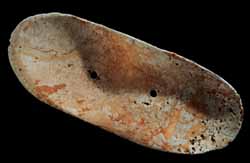 |
Marine shell gorget, Ester Berry site, Fulton County. |
Archaeologists have found many types of Woodland ornaments in their excavations. A piece of marine shell was shaped and drilled to make a gorget, an ornament that hung from the neck. Gorgets were made by Native Americans from the Archaic period to the Historic period. This specimen was made during the Early Woodland period. At least 3,000 years ago, Native Americans living in Illinois were able to acquire marine shell from the Gulf of Mexico and Atlantic Ocean. They probably exchanged different materials from Illinois or elsewhere for shell.
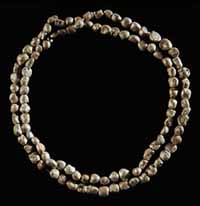 |
Freshwater pearl necklace, Liverpool site, Fulton County. |
There are many other Middle Woodland period ornaments. Strands of freshwater pearls were found at the Liverpool site in Fulton County. The pearls were drilled and strung to make a necklace. How would you drill a hole in a pearl? Native American used small splinters of stone to drill a hole without splitting the pearl. Archaeologists call these tools microdrills.
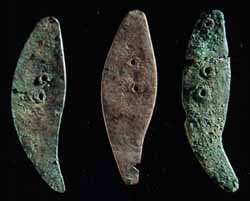 |
Copper replicas of bear canine pendants, Liverpool site, Fulton County. |
Bear canines, the conical teeth that occur between the incisors and bicuspids, were drilled and suspended around the neck as pendants. Imitation bear canines were also made of copper and worn as ornaments. These examples are shaped like bear canine teeth, and they have two small holes perhaps to fasten them to clothing.
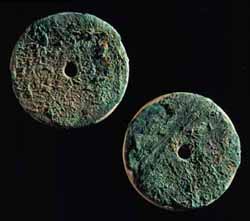 |
Copper-covered earspools, Dickson Mounds, Fulton County. |
Earspools-wooden, clay, and sometimes metal disks-were inserted in a slit in the ear lobe as illustrated by the clay figurine below. Although these examples are Mississippian, Woodland period earspools are similar in shape and design.
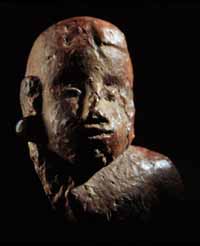 |
Clay figurine with earspools, Larson site, Fulton County. |
Notice the small circular ornaments placed in the ear lobe of this figurine.
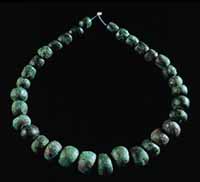 |
Copper bead necklace, Hannah site, Peoria County. |
Other ornaments include pendants made from marine shell and copper beads such as these found in Peoria County.
|
|
Copyright © 2000 Illinois State Museum